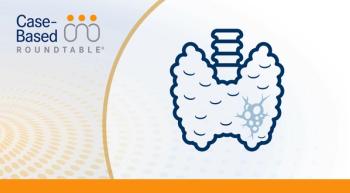
Real-World Data on Older Patients With RAI-Refractory DTC
A medical oncologist reviews real-world data on older patients with RAI-refractory DTC and provides her thoughts on treating this patient population.
Episodes in this series

Case: A 64-Year-Old Woman with DTC
Initial presentation
- A 64-year-old woman presents with a painless “lump on her neck” with occasional swelling. She states she noticed this just a few days after returning from vacation.
- PMH: Hyperlipidemia managed with medication; COPD
- PE: palpable, non-tender solitary right-of-the midline neck mass; mobile supraclavicular mass on the same side; otherwise unremarkable
Clinical workup and initial treatment
- Labs: TSH WNL
- Ultrasound of the neck revealed a 3.3-cm suspicious right mass in the lobe of the thyroid; 2 suspicious supraclavicular lymph nodes (LNs), largest 2.0 cm in size.
- Ultrasound-guided FNAB of the thyroid mass and the largest LN confirmed papillary thyroid carcinoma.
- Patient underwent total thyroidectomy with central compartment node dissection and right selective neck dissection.
- Pathology: 3.0-cm papillary thyroid cancer, columnar cell variant; 4/14 lateral positive LN, 3/3 central positive LN
- Largest lateral node was 2.2 cm with no extra-nodal extension
- Margins were negative
- Microscopic extrathyroidal extension present
- Probable stage II; T2N1bM0 papillary thyroid cancer
Subsequent treatment and follow-up
- She was treated with radioactive iodine 150 millicuries
- Whole body scan showed uptake in the neck, consistent with remnant thyroid tissue
- She was started on levothyroxine suppression therapy
- Follow-up at 6 months
- TSH 0.1 µU/mL, thyroglobulin 24 ng/mL (negative anti-thyroglobulin antibodies)
- Chest CT scan showed 8 small bilateral lung nodules only several mm in size
- Next-generation sequencing was negative for mutations, rearrangements
- Follow-up CT chest scan and blood tests 3 months later
- Thyroglobulin increased
- Lung nodules had increased by up to 1 cm in size
- Lenvatinib 24mg po qd was initiated
This is a video synopsis/summary of a Case-Based Peer Perspective featuring: Lori Wirth, MD.
Wirth discusses real-world treatment patterns and clinical outcomes in older patients with radioactive iodine (RAI)–refractory differentiated thyroid cancer (DTC) treated with lenvatinib. A recent abstract presented at the American Thyroid Association 2023 meeting by the University of Michigan group reported on over 100 patients 65 years and older who were mostly treated with first-line lenvatinib. The median treatment duration was 17 months, and the median progression-free survival (PFS) had not been reached. The 12-month and 48-month median PFS rates were 75% and 52%, respectively, suggesting good activity and tolerability of lenvatinib in this older population.
These real-world findings mirror the data from the SELECT trial, where a subset analysis of patients 65 years and older showed an overall survival benefit in the randomized phase 3 trial. Wirth emphasizes that older age alone should not preclude treatment with lenvatinib, as these patients can benefit from therapy when they have RAI-refractory DTC. However, she notes that caution is needed due to the higher prevalence of comorbidities, particularly hypertension, and frailty in the older population. Close monitoring is essential as patients begin therapy, but older patients can be treated with VEGFR multikinase inhibitors such as lenvatinib.
Video synopsis is AI-generated and reviewed by Targeted Oncology® editorial staff.










































